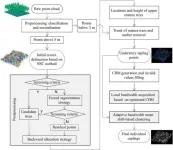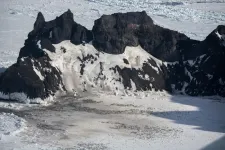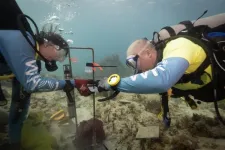(Press-News.org) Small wearable or implantable electronics could help monitor our health, diagnose diseases, and provide opportunities for improved, autonomous treatments. But to do this without aggravating or damaging the cells around them, these electronics will need to not only bend and stretch with our tissues as they move, but also be soft enough that they will not scratch and damage tissues.
Researchers at Stanford have been working on skin-like, stretchable electronic devices for over a decade. In a paper published March 13 in Nature, they present a new design and fabrication process for skin-like integrated circuits that are five times smaller and operate at one thousand times higher speeds than earlier versions. The researchers demonstrated that their soft integrated circuits are now able to drive a micro-LED screen and detect a braille array that is more sensitive than human fingertips.
“We’ve made a significant leap forward. For the first time, stretchable integrated circuits are now small enough and fast enough for many applications,” said Zhenan Bao, a K. K. Lee Professor in Chemical Engineering at Stanford and senior author on the paper. “We hope that this can make wearable sensors and implantable neural and gut probes more sensitive, operate more sensors, and potentially consume less power.”
Flexible, stretchable, and functional
The core of the circuits are stretchable transistors made from semiconducting carbon nanotubes and soft elastic electronic materials developed in Bao’s lab. Unlike silicon, which is hard and brittle, the carbon nanotubes sandwiched between elastic materials have a fishnet-like structure that allows them to continue to function while they stretch and deform. The transistors and circuits are patterned onto a stretchable substrate, along with stretchable semiconductor, conductor, and dielectric material.
“This is many years of material and engineering development,” Bao said. “We not only needed to develop new materials, but we also needed to develop the circuit design and the fabrication process to make the circuits. There are many layers stacked together and if one layer doesn’t work, we have to restart everything from scratch.”
In one demonstration of their new stretchable electronics design, the researchers were able to fit more than 2,500 sensors and transistors into a square centimeter, creating an active-matrix tactile array over ten times more sensitive than human fingertips. The researchers showed that the sensor array can detect the locations and orientation of tiny shapes or recognize whole words in Braille.
“With Braille, you usually sense one letter at a time,” said Donglai Zhong, a postdoctoral researcher in Bao’s lab and co-first author on the paper. “With such a high resolution, you could sense a whole word, or potentially a whole sentence, with just one touch.”
The researchers also used their stretchable circuits to drive a micro-LED display with a refresh rate of 60 Hz, which is the typical refresh rate of a computer or TV screen. Previous versions of the stretchable circuits weren’t fast enough at small sizes to generate enough current to accomplish this.
“We’re really excited about these performance improvements because they enable us to do a lot of new things,” said Can Wu, a postdoctoral researcher in Bao’s lab and co-first author on the paper. “Preliminary results demonstrate that our transistor can be used to drive commercial displays commonly used in computer monitors, for example. And for biomedical applications, a high-density, soft, and conformable sensing array could allow us to sense human body signals, such as from our brains and muscles, at a large scale and fine resolution. This could lead to next-generation brain-machine interfaces that are both high-performance and biocompatible.”
Soft circuits for the future
The researchers intentionally developed materials and processes that could work with existing fabrication tools, so that the circuits could make the jump to commercial manufacturing more easily. Their process relies on fabrication techniques similar to what is currently used for making display screens, although the materials involved are entirely different. Manufacturers wouldn’t be able to make these circuits without some additional fine-tuning, but the tools are already in place, Bao said.
Of course, there are more hurdles before these stretchable and soft integrated circuits can be ready for commercialization. Body and tissue movement can still cause some variation in the electrical characteristics of the circuits – Bao and her colleagues are working on new designs that could reduce these effects – and the devices will need some sort of soft moisture protection before they can be put to use.
“There are still challenges for the future of this technology, but these recent developments open up some very exciting biomedical applications for wearable and implantable electronics,” Bao said. “And it also has applications in soft robotics, giving robots a sensing functionality that approaches that of humans and makes them safer for people to work with.”
Bao is a member of Stanford Bio-X, the Stanford Cardiovascular Institute, the Wu Tsai Human Performance Alliance, the Wu Tsai Neurosciences Institute, and the Maternal & Child Health Research Institute; an affiliate of the Precourt Institute for Energy and the Stanford Woods Institute for the Environment; and a faculty fellow of Sarafan ChEM-H. Bao is an investigator of CZ-Biohub-San Francisco and an innovation investigator of Arc Institute.
Other Stanford co-authors of this research include research scientist Jeffrey B.-H. Tok; postdoctoral researchers Yuanwen Jiang (Co-first-author), Min-gu Kim, Chien-Chung Shih, Jian-Cheng La, Chuanzhen Zhao, Shiyuan Wei, Xiaozhou Ji, Yi-Xuan Wang, Chengyi Xu, Naoji Matsuhisa, Yusheng Lei, Deya Liu, Song Zhang, and Yuto Ochiai; and doctoral students Yujia Yuan, Yuya Nishio, Weichen Wang, Theodore Z. Gao, Yu Zheng, Zhiao Yu, Huaxin Gong, and Shuhan Liu.
This work was funded by SAIT, Samsung Electronics Co, Ltd, Army Research Office, CZ Biohub-San Francisco, Stanford Wearable Electronics Initiative, and the National Science Foundation.
END
Advancing toward wearable stretchable electronics
2024-03-13
ELSE PRESS RELEASES FROM THIS DATE:
Menopause explains why some female whales live so long
2024-03-13
Females of some whale species have evolved to live drastically longer lives so they can care for their families, new research shows.
The study focussed on five whale species that – along with humans – are the only mammals known to go through menopause.
The findings show that females of these whale species that experience menopause live around 40 years longer than other female whales of a similar size.
By living longer without extending their “reproductive lifespan” (the years in which they breed), these ...
Supply chain disruptions will further exacerbate economic losses from climate change
2024-03-13
UCL Press Release
Under embargo until Wednesday 13 March 2024, 16:00 UK time / 12:00 US Eastern time
Global GDP loss from climate change will increase exponentially the warmer the planet gets when its cascading impact on global supply chains is factored in, finds a new study led by UCL researchers.
The study, published in Nature, is the first to chart “indirect economic losses” from climate change on global supply chains that will affect regions that would have been less affected by projected warming temperatures.
These previously unquantified disruptions in supply chains will further exacerbate projected economic losses due ...
The SNF Institute for Global Infectious Disease Research announces new advisory board
2024-03-13
From identifying the influenza virus that caused the pandemic of 1918 to developing vaccines against pneumococcal pneumonia and bacterial meningitis in the 1970s, combating infectious disease has a rich history at Rockefeller. That tradition continues as the Stavros Niarchos Foundation Institute for Global Infectious Disease Research at Rockefeller University (SNFiRU) caps a successful first year with the establishment of a new advisory board.
This international advisory board was created in part to give guidance on how to best use ...
How the brain wakes us from daydreams
2024-03-13
When we daydream, we must be able to snap back to attention at a moment’s notice. Researchers at Boston Children’s Hospital uncovered how our brains can do things like react to a question when we’re daydreaming: firing activity in part of the brain called the dentate gyrus keeps us focused on what’s happening in our environment. And the team found that the same neural activity also helps with forming memories. The findings were published in Nature on March 13, 2024.
“We have found a brain mechanism for breaking up periods of mind wandering and realigning the ‘cognitive ...
Revolutionizing forest management: unveiling understory saplings with advanced airborne LiDAR technology
2024-03-13
The regeneration of forest saplings is pivotal for maintaining biodiversity and ecosystem productivity, necessitating innovative management techniques for continuous forest coverage. Traditional 2-dimensional remote sensing struggles to accurately capture the complex, understory sapling dynamics. To address this, researchers are exploring the use of aerial laser scanning (ALS) for its potential in providing detailed 3-dimensional insights. However, despite progress in using ALS data to estimate tree metrics, accurately identifying and quantifying the phenotypic ...
High resolution imagery advances the ability to monitor decadal changes in emperor penguin populations
2024-03-13
Woods Hole, Mass. (March 13, 2024) - Emperor penguin populations have been exceedingly difficult to monitor because of their remote locations, and because individuals form breeding colonies on seasonal sea ice fastened to land (known as fast ice) during the dark and cold Antarctic winter.
Now, new research that incorporates very high resolution (VHR) satellite imagery with field-based validation surveys and long-term data has provided the first multi-year time series that documents emperor penguin global population trends.
Researchers ...
Gilbert H. L. Tang appointed Editor-in-Chief of JACC: Case Reports
2024-03-13
Renowned cardiovascular surgeon Gilbert H. L. Tang has been named Editor-in-Chief of JACC: Case Reports, bringing a wealth of experience and expertise to the helm of one of the top cardiovascular journals published by the American College of Cardiology.
“I am both honored and humbled to be a cardiac surgeon among the Editor-in-Chiefs in the JACC family of journals,” Tang said. “It is going to be an exciting time for JACC: Case Reports to build on a team of multidisciplinary cardiovascular practitioners with diverse backgrounds and experiences, and at different stages of their professional careers, to enhance the journal’s academic and educational impact globally.”
Tang ...
Enhancing crop nutritional analysis: a leap towards precision agriculture with multi-target regression and hyperspectral imaging
2024-03-13
Recent advancements in hyperspectral imaging and machine learning have revolutionized the non-destructive monitoring of crop nutritional status, enabling accurate prediction of plant element concentrations. Despite successes, the single-target regression method, which predicts concentrations individually, faces accuracy limitations for certain elements. Traditional methods offer accuracy but at the cost of being destructive and inefficient for large-scale use. Current research highlights the potential of multi-target ...
Sonic youth: Healthy reef sounds increase coral settlement
2024-03-13
Woods Hole, Mass. – A healthy coral reef is noisy, full of the croaks, purrs, and grunts of various fishes and the crackling of snapping shrimp. Research suggests that larval animals use this symphony of sounds to help them determine where they should live and grow.
Researchers at the Woods Hole Oceanographic Institution (WHOI) recently demonstrated that replaying healthy reef sounds could potentially be used to encourage coral larvae to recolonize damaged or degraded reefs. A reef that has been ...
Warwick awarded £11 million to train PhD students in computational modelling
2024-03-13
The University of Warwick has been awarded £11m to train PhD students in computational modelling.
The new centre will train 50 PhD students to use computational modelling to tackle pressing global sustainability challenges from accessing clean fusion energy, controlling infectious diseases, to designing energy-efficient devices such as new battery electrolytes.
The Centre for Doctoral Training in Modelling of Heterogeneous Systems (HetSys II), led by Professor James Kermode from the School of Engineering, Dr Livia Bartok-Partay from Chemistry and Professor Nicholas Hine from Physics, will train ...








